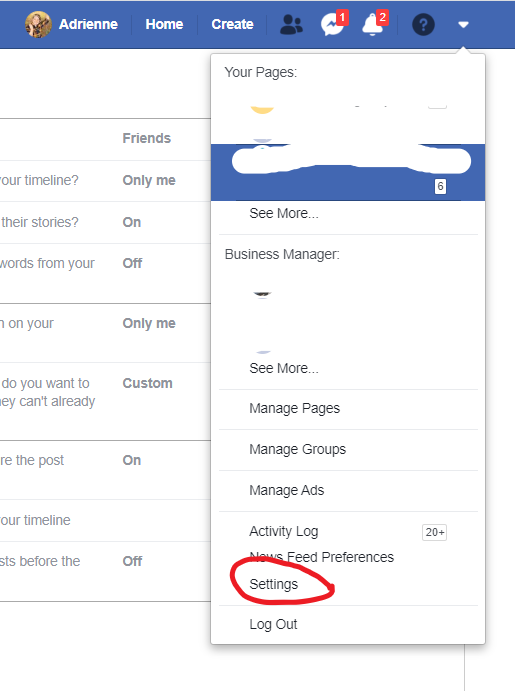Social media is great – there are many positive aspects that come from a connected world! We can catch up with old friends, learn new things, and be exposed to others’ creativity.
However, social media is a responsibility. Similar to having a credit report that you need to monitor, your social media presence should be reviewed at least once a year. Platforms are always changing and adding features, which means the onus is on the users (us!) to make sure new features and functions are meeting the level of privacy we desire.
The first step in reviewing your privacy settings on any channel is to intentionally decide three things:
- What personal details am I willing to give to the social channel for an optimal experience?
- What personal details am I unwilling to give to the social channel, understanding that some features and functions will not be available to me?
- What kind of network or audience am I willing to connect with on this network? Will this network be for people I already know? Or am I okay with being followed or friend requested by people with no connection to me?
This might force you to do some research on a social channel before you join it. Which is great! It is always good practice to think about what personal data you are giving to companies before you sign up for a digital service.
Here, we are going to be reviewing Facebook specifically, but the same ideas apply to all other social networks.
Once a year, schedule a review of your privacy settings and see if any new features need your attention. Two great examples are Stories and Facial Recognition. Stories were added to Facebook in 2017, and with this new content stream source, you need to think about who can tag you in Stories and who can share your Stories. Facial Recognition is a feature that was added in 2012 and allows users to quickly tag people by recognizing their faces in photos. However – many people might not be eager to have their face ‘recognized’ and remembered by Facebook. So, let’s get familiar with some settings!
Facebook’s Privacy Settings
Let’s dive in! To find Facebook Settings, navigate to the upper right-hand corner of your profile and click the ‘carrot’ arrow to get a larger menu. Then scan the choices and select ‘Settings’ (see below).

Now you should come to a screen with a menu on the left that looks like this:

I’m going to go through, in general, each section of this menu, and note any key data you should keep an eye on!
GENERAL
This is a very general section – mostly what we need to think about here is our email address attached to our Facebook page. Something that many people might not realize, is that if you use the same email for Facebook as for other online accounts (banking, online shopping, Amazon) it makes it very easy for those accounts to target you with online offers and deals. It also makes it difficult if that one email is hacked – see our recent blog post ‘What the Hack’ on preventing hacking.
SECURITY AND LOGIN
Here we get to the good stuff. In Security and Login, you can:
- Change your password! Change it every quarter if you can! You can also enable two-factor authentication which we always recommend for security purposes.
- You can assign friends to help you if you get locked out of your account.
- Review all sessions of Facebook. This will show you where and on what devices you’ve used Facebook. You should check this out, and click ‘log out’ of individual sessions if needed. This will occur if you travel frequently, as each time you log in to a new wifi network, you’ll start a new ‘session’ of Facebook. Also, if you log into a public device (library computer) or a friend’s device, you want to make sure that you are completely logged off.
- You can also review what devices you don’t need to re-login to here, and where you would like to ‘remember your password’. Just keep in mind – if your device is lost or stolen, someone else might gain access.
YOUR FACEBOOK INFORMATION
This section has to do with your data. In this section you can: deactivate Facebook, download all your data, you can even ‘access your information’ which is fascinating. In the ‘access your information’ section, you can see all your comments, likes, friends, photos, and more. It’s literally a categorization of all the actions you’ve taken on Facebook. If you keep on scrolling, there is a section about information about you. It has information about what types of advertisers are advertising to people like you, it has your location history if you have turned that feature on. It has all your data – which you can adjust and change if you’d like.
PRIVACY
Next, we have the privacy section. In this section, you choose how people can send you friend requests, how they can find you, and who can see your activity. There are different levels of how people can send you requests, from ‘no one’ to only people who are friends with people you know, to everyone! You can also limit what certain audiences see – from what goes public to what only YOUR network can see.
Another key part of this section is the search engine option. It asks ‘do you want search engines outside of Facebook to link to your profile?’. This basically means that, if you have this feature ON, Google or Bing or Yahoo will bring up your Facebook page if someone searches your name. If you are fine with that – great! However, for privacy’s sake, I always leave that function OFF.
TIMELINE AND TAGGING
Have you ever been with a group of people for an event, and lots of photos were taken – but you didn’t have a say whether those photos were posted on social media? Would you rather review and look at photo tags of yourself before they are up on the internet for others to see? Some people don’t mind it – but if you’ve ever been to a rambunctious wedding or wild night at a bar, you might cringe at what photos people got of you. Even if you are 100% well-behaved, you still might want to see what people post on Facebook where you are tagged. In Timeline and Tagging you can control who and how you are tagged – or if you are tagged at all. You can control other people posting on your timeline, and even shut your timeline off completely. In the chaotic world of Facebook, your timeline and how you’re tagged is really the only place you can control content about you.
*Note: Just because you limit others tagging you, does not mean people can’t post photos of you online that they have taken. They can post them – they just can’t tag you. The ethics of taking photos of others in public is a subject for another blog post!
STORIES
Stories are a newer feature which are basically posts that can live for 24 hours, and then ‘disappear’ from the platform. They are a fun in-the-moment way to share updates. However, you can control if other people share YOUR stories to their stories.
LOCATION
Location services basically track where you go. If you go to the same Starbucks, shopping center, or fly into a certain airport, location services will know. This service allows businesses to know how many people are physically in their stores, and offer those people discounts and ads. Location services also help users with navigation, news and events of the goings-on around them. Personally – I have deleted all my location data and turned the feature off. For me, as I outlined at the beginning of this blog post, I don’t want Facebook to log my habits as I move about my life. I generally have turned ‘off’ location services on all my social media accounts, and that is one of my social media rules that I live by. For some users, the convenience is worth it. But, I’d still recommend taking a look and seeing how much Facebook knows about your daily habits and whereabouts.
BLOCKING
For ex-partners, ex-friends, irritating pages, apps, games, and even just people who grind your gears – you can block them! If you block someone, they cannot see anything about you, and you cannot see anything about them. Need we say more?
We will say, that if you want to un-block someone (what? Maybe you’re curious and it’s been years!) you can’t re-block them for 48 hours. So, if you are going to snoop, you have to be ok with being available for them to find you for 48 hours till the block can be re-engaged.
LANGUAGE AND REGION
Unless you are moving across the globe frequently, this doesn’t change much. However, these settings are great for people who are bilingual and work or live in bilingual environments or cultures!
FACE RECOGNITION
Do you want Facebook to recognize you in photos and videos? If you do, that’s great! If not, then click ‘no’. We leave it up to your discretion for this feature, but we’ve seen enough science fiction movies that this feature makes us wary!
SETTINGS CONTINUED
We encourage you to poke around and look at the other settings that Facebook has available. In fact, making a habit of poking around settings in all digital platforms is a great skill to have! To be a good digital citizen, it is important to know as much as you can about the tools that you are using – because just like we lock our doors and take drivers’ safety IRL, we need to understand and be prepared for the digital world with its pros and cons.
We think it is critical to note that digital tools can enable our lives to be easier. However, sometimes ease turns into passivity. We have apps and accounts with our name, email, phone number, and possibly location services, search history, and more, littered across the internet. If we don’t create and use tools with intention and maintain them, it might result in stolen identity, a hacked account, or embarrassing information made public. I created my Facebook profile in September, 2005 – and if I had just left the settings as they were then – I’d be sad!
So set an alarm or mark your calendar so you’ll remember to review your privacy settings often!



Recent Comments